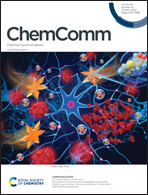Photoinduced ligand to metal charge transfer enabling cerium mediated decarboxylative alkylation of quinoxalin-2(1H)-ones†
Abstract
Here, we report the cerium-mediated decarboxylative alkylation of quinoxalin-2(1H)-ones utilizing feedstock carboxylic acids as a radical precursor via photoinduced-LMCT. This operationally simple protocol overcomes the limitation of the direct use of carboxylic acids to access alkyl radicals. Spectroscopic investigations reveal the photoinduced LMCT and CO2 evolving events. We have utilized a broad range of alkyl carboxylic acids (1° to 3° acids), amino acids and pharmaceutically-important acids as a coupling partner to synthesise the desired alkylated heterocyclic product in good to excellent yields.



 Please wait while we load your content...
Please wait while we load your content...